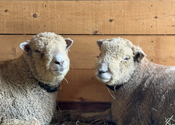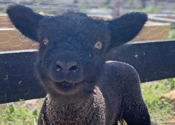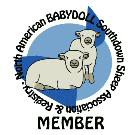People occasionally ask if Babydolls can be milked. In
2015, my husband and I milked 10 ewes for almost a
month, and I would like to share that story
Each evening, starting when most of the lambs were
about 6 weeks, we separated the lambs from their
mothers, keeping them in a pen in a shed while the ewes
went back out on grass. They could hear but not see each
other. The lambs got some grain, and didn’t suffer any
noticeable damage from the loss of part of their milk
supply. About 9 hours later, at 5 A.M., we rounded the
ewes back up and started the milking rodeo. I wish I had
taken pictures of the milking process, but I didn’t. Some
of the girls were more cooperative than others, but none
were 100% submissive.
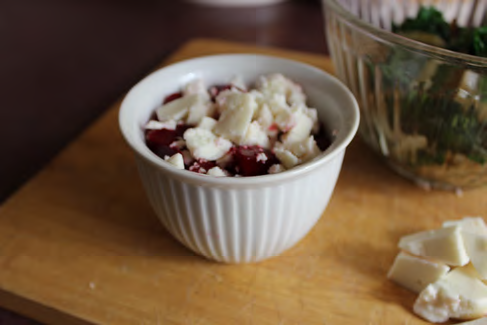 Feta made with Babydoll
sheep milk.
Feta made with Babydoll
sheep milk.The “stanchion” was simple – 2
T-posts
driven into the
ground in a “V” shape so that when an
ewe’s head was
high, it fit easily between them, but when it was low,
she couldn’t back up. We tied the halter rope to a post
in front of her so she could put her head down into
the grain bucket, but not up. Then each of us held a
container below our side of the udder, sat on a bucket or
low stool, and milked until it was mostly empty. Milking
these sheep is a 3-finger task, and by that I mean thumb
plus 2 fingers. You get the hang of it after a little practice.
We averaged a little less than 10 minutes per ewe, so the
whole group of 10 took close to an hour and a half.
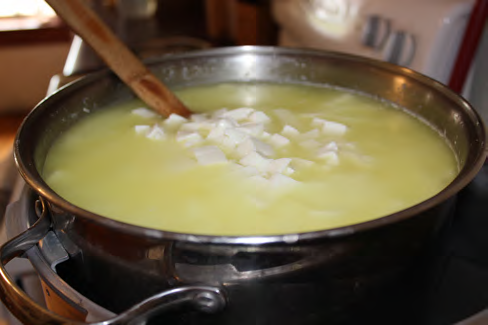 Stirring the curds.
Stirring the curds.
Nothing gives you insight into which ewes have the
best udders like milking these sheep—an important
consideration in my breeding program. One got
nicknamed “tiny tits,” and she had the lowest milk
yield
besides being difficult to milk. Yield ranged from ½ cup
to 2 cups per ewe, with about a cup being average (dairy
sheep give about 8 cups a day, in 2 milking sessions). At
the time, we thought the ewe who usually gave 2 cups
just had the highest capacity, and while she does have a
really well-shaped and productive udder, I later realized it
was probably partly due to her twins being several weeks
younger than the rest. Ewes really pour their energy into
making milk for those lambs, and milk production
drops fairly quickly as the lambs get older and start to
depend on other food. We got 2 to 2.5 quarts a day,
with yield dropping as they got farther out from their
lambing dates, and into hotter summer weather.
After turning everybody back out onto pasture together,
we strained the milk through a cloth and headed to the
house with it. Often our kids were up by then and had
been out to visit us. We kept it in the fridge until there
was enough for a batch of cheese—usually 2 gallons.
The milk was rich and had more flavor than “normal”
milk, but was still quite mild and nice to drink. Milk to
cheese ratio was 1 to 1.5 lbs. per gallon.
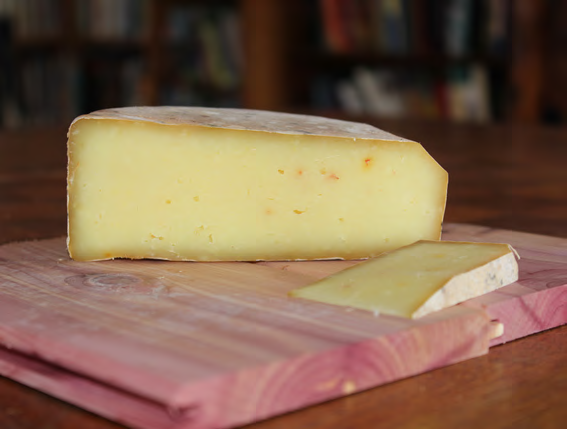 Aged manchego cheese -
Didn't taste as good as it looked.
Aged manchego cheese -
Didn't taste as good as it looked.
We made several types of cheese, mostly those
traditionally made with sheep milk, including
Romano, feta, Gouda, paneer, ricotta, and manchego, following
instructions from a book
about cheesemaking. It was all good, except the
Manchego we tried to age. Six months later, it
was firm and beautiful and had a nice smooth
texture, but a brown mold on the outside had
caused the flavor to go off. Our cellar-type
storage area probably didn’t have adequate
airflow. The yogurt was also very good.
We have talked about doing this again, but there
always seems to be a reason such a large time
commitment is impractical. I have more ewes
now, and if I were to do it again, I might separate
them into two groups and only milk those that
had singles.
This video looks like a good resource on How to Milk a Sheep by The
Grass-fed Homestead
https://www.youtube.com/watch?v=ku34i-LOFUg
If you have photos of food products you've made with milk from your
Babydolls, please share with us.
Send
an e-mail.
Updated
as of 11/2025





